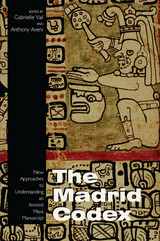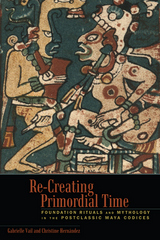3 books about Vail, Gabrielle

Astronomers, Scribes, and Priests
Intellectual Interchange between the Northern Maya Lowlands and Highland Mexico in the Late Postclassic Period
Gabrielle Vail
Harvard University Press, 2010
Astronomers, Scribes, and Priests examines evidence for cultural interchange among the intellectual powerbrokers in Postclassic Mesoamerica, specifically those centered in the northern Maya lowlands and the central Mexican highlands. Contributors to the volume’s thirteen chapters bring an interdisciplinary perspective to understanding the interactions that led to shared content in hieroglyphic codices and mural art. The authors address similarities in artifacts, architectural styles, and building alignments—often produced in regions separated by hundreds of miles—based on their analyses of iconographic, archaeological, linguistic, and epigraphic material. The volume includes a wealth of new data and interpretive frameworks in this comprehensive discussion of a critical time period in the Mesoamerican past.
[more]

The Madrid Codex
New Approaches to Understanding an Ancient Maya Manuscript
Gabrielle Vail
University Press of Colorado, 2004
This volume offers new calendrical models and methodologies for reading, dating, and interpreting the general significance of the Madrid Codex. The longest of the surviving Maya codices, this manuscript includes texts and images painted by scribes conversant in Maya hieroglyphic writing, a written means of communication practiced by Maya elites from the second to the fifteenth centuries A.D. Some scholars have recently argued that the Madrid Codex originated in the Petén region of Guatemala and postdates European contact. The contributors to this volume challenge that view by demonstrating convincingly that it originated in northern Yucatán and was painted in the Pre-Columbian era. In addition, several contributors reveal provocative connections among the Madrid and Borgia group of codices from Central Mexico.
Contributors include: Harvey M. Bricker, Victoria R. Bricker, John F. Chuchiak IV, Christine L. Hernández, Bryan R. Just, Merideth Paxton, and John Pohl. Additional support for this publication was generously provided by the Eugene M. Kayden Fund at the University of Colorado.
[more]

Re-Creating Primordial Time
Foundation Rituals and Mythology in the Postclassic Maya Codices
Gabrielle Vail and Christine Hernández
University Press of Colorado, 2013
Re-Creating Primordial Time offers a new perspective on the Maya codices, documenting the extensive use of creation mythology and foundational rituals in the hieroglyphic texts and iconography of these important manuscripts. Focusing on both pre-Columbian codices and early colonial creation accounts, Vail and Hernández show that in spite of significant cultural change during the Postclassic and Colonial periods, the mythological traditions reveal significant continuity, beginning as far back as the Classic period.
Remarkable similarities exist within the Maya tradition, even as new mythologies were introduced through contact with the Gulf Coast region and highland central Mexico. Vail and Hernández analyze the extant Maya codices within the context of later literary sources such as the Books of Chilam Balam, the Popol Vuh, and the Códice Chimalpopoca to present numerous examples highlighting the relationship among creation mythology, rituals, and lore. Compiling and comparing Maya creation mythology with that of the Borgia codices from highland central Mexico, Re-Creating Primordial Time is a significant contribution to the field of Mesoamerican studies and will be of interest to scholars of archaeology, linguistics, epigraphy, and comparative religions alike.
Remarkable similarities exist within the Maya tradition, even as new mythologies were introduced through contact with the Gulf Coast region and highland central Mexico. Vail and Hernández analyze the extant Maya codices within the context of later literary sources such as the Books of Chilam Balam, the Popol Vuh, and the Códice Chimalpopoca to present numerous examples highlighting the relationship among creation mythology, rituals, and lore. Compiling and comparing Maya creation mythology with that of the Borgia codices from highland central Mexico, Re-Creating Primordial Time is a significant contribution to the field of Mesoamerican studies and will be of interest to scholars of archaeology, linguistics, epigraphy, and comparative religions alike.
[more]
READERS
Browse our collection.
PUBLISHERS
See BiblioVault's publisher services.
STUDENT SERVICES
Files for college accessibility offices.
UChicago Accessibility Resources
home | accessibility | search | about | contact us
BiblioVault ® 2001 - 2024
The University of Chicago Press









